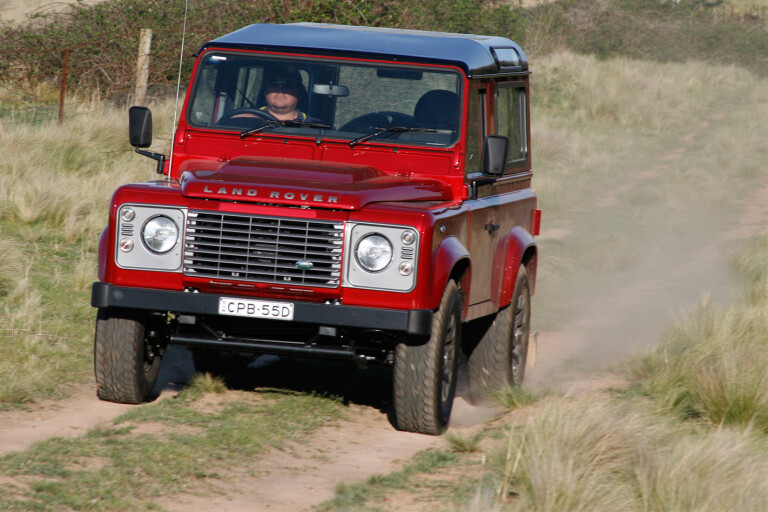
The Land Rover Defender is a 4x4 icon with few peers but its time is almost up.
Climb inside the Defender 90 and it’s like climbing into history. And by that I don’t just mean that the Defender is old-school and a throwback to the past.
It is, of course, both of those things, but it’s also much more. This Defender is the latest – and close to the last – in a long line of utilitarian Land Rovers that date back to 1948. Being a short (90-inch) wheelbase model (hence the ‘90’ designation), it’s also closest to the original 80-inch-wheelbase Land Rover.
 The Defender remains both charming and frustrating. Even climbing up into the lofty cabin is a challenge for anyone but the young and athletic as there isn’t a grab-handle or a step to facilitate easy entry. And once on board you adjust your frame to the Defender, not the other way around. The Defender has a fixed steering wheel (not even reach adjustment), and there’s no height adjustment for the seat.
The Defender remains both charming and frustrating. Even climbing up into the lofty cabin is a challenge for anyone but the young and athletic as there isn’t a grab-handle or a step to facilitate easy entry. And once on board you adjust your frame to the Defender, not the other way around. The Defender has a fixed steering wheel (not even reach adjustment), and there’s no height adjustment for the seat.
On the road, the Defender 90 is very much a light-truck rather than a modern passenger-style 4x4. In comparison to something like its Discovery 4 stablemate, it feels like a truck, steers like a truck and rides like a truck. That’s something you either love or hate.
 What you can’t help but love is the energy and enthusiasm that emanates from the Ford-sourced ‘Puma’ 2.2-litre four-cylinder diesel engine introduced for 2012, replacing the previous 2.4-litre engine, an excellent but older and less environmentally friendly unit from the Puma family. The 2.2 is a champ of an engine that punches well above its claimed 90kW. With new noise deadening (also introduced in 2012) and a wide-ratio six-speed gearbox, introduced with the previous 2.4-litre engine in 2007, it’s surprisingly quiet and fuss-free on the highway, though not so economical at higher speeds.
What you can’t help but love is the energy and enthusiasm that emanates from the Ford-sourced ‘Puma’ 2.2-litre four-cylinder diesel engine introduced for 2012, replacing the previous 2.4-litre engine, an excellent but older and less environmentally friendly unit from the Puma family. The 2.2 is a champ of an engine that punches well above its claimed 90kW. With new noise deadening (also introduced in 2012) and a wide-ratio six-speed gearbox, introduced with the previous 2.4-litre engine in 2007, it’s surprisingly quiet and fuss-free on the highway, though not so economical at higher speeds.
The Defender’s blunt nose and flat windscreen simply don’t do anything for aerodynamic efficiency and pushing hard will see the small 60-litre tank drain with alarming speed. Not that you push the 90 through corners. It’s very much a steady-as-she-goes drive, but it is still surprisingly long-legged on straight roads.
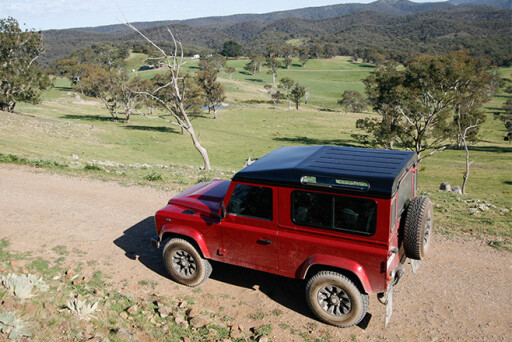 Off-road, the 90 is both brilliant and disappointing, very much like the vehicle as a whole. The high ground clearance, short overhangs and short overall length are major pluses. The vision is great, too. This is what makes a genuine off-road vehicle rather than a trail vehicle: a vehicle for explorers, rather than a vehicle for those who follow in their paths.
Off-road, the 90 is both brilliant and disappointing, very much like the vehicle as a whole. The high ground clearance, short overhangs and short overall length are major pluses. The vision is great, too. This is what makes a genuine off-road vehicle rather than a trail vehicle: a vehicle for explorers, rather than a vehicle for those who follow in their paths.
Not so good are the huge turning circle, the only-okay wheel travel and an electronic traction-control system that’s not as effective as it could be. For a live-axle 4x4, the Defender’s ability to maintain traction on deeply rutted and broken ground is frankly disappointing. Perhaps it’s the too-firm anti-roll bars. If this 90 were mine, the anti-roll bars would be the first thing to be junked.
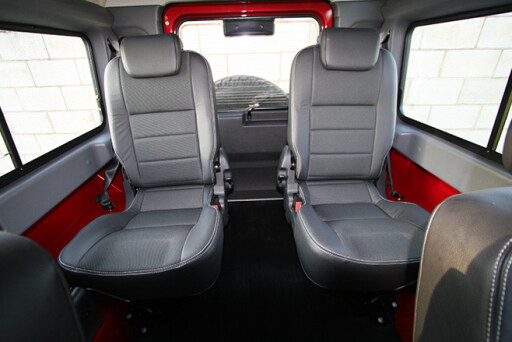 The 90 might seem small on the outside, but it is the ‘Tardis’ of 4x4s with what is a surprisingly cavernous interior thanks to the body’s slab-sided shape and high roof. The two rear seats are also surprising roomy and comfortable, with easy walk-through access from behind, but the B-pillar crossbrace limits rear-seat legroom, which is about the only negative for passengers in the back. Thanks to a fold-down step and grab handle, it’s actually easier to get into the rear of the 90 then it is to get into the driver’s seat.
The 90 might seem small on the outside, but it is the ‘Tardis’ of 4x4s with what is a surprisingly cavernous interior thanks to the body’s slab-sided shape and high roof. The two rear seats are also surprising roomy and comfortable, with easy walk-through access from behind, but the B-pillar crossbrace limits rear-seat legroom, which is about the only negative for passengers in the back. Thanks to a fold-down step and grab handle, it’s actually easier to get into the rear of the 90 then it is to get into the driver’s seat.
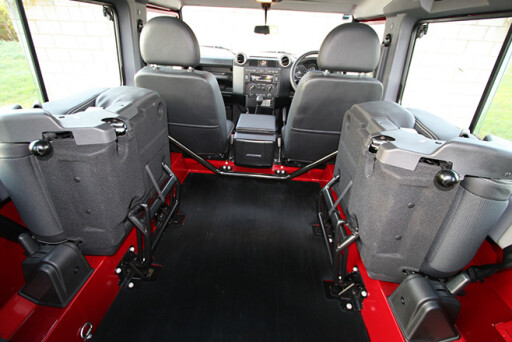 Perhaps the most annoying thing about the 90 is the noise from stones hitting the undersides of the wheelarches on gravel roads. It sounds like the crack of a small-bore rifle! The rear mudflaps are also poorly thought-out. At highway speeds the flaps ride up with the wind and the top corner of the passenger-side flap is directly in line with the hot exhaust-gas stream, causing it to melt.
Perhaps the most annoying thing about the 90 is the noise from stones hitting the undersides of the wheelarches on gravel roads. It sounds like the crack of a small-bore rifle! The rear mudflaps are also poorly thought-out. At highway speeds the flaps ride up with the wind and the top corner of the passenger-side flap is directly in line with the hot exhaust-gas stream, causing it to melt.
Nit-picking aside, time behind the wheel of the 90 can’t help but have you won over by its charm. Even the initially awkward driving position becomes comfortable with familiarity. When I first jumped into the 90, I thought: “Do I really have to drive this for two weeks?”
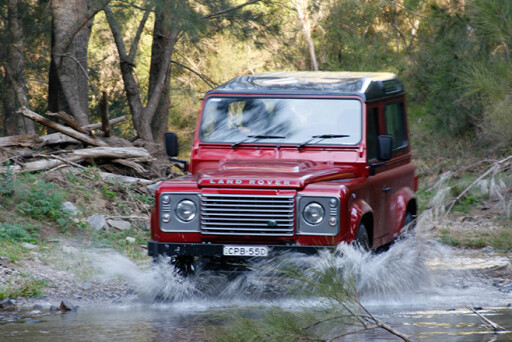 Two weeks later, I thought: “Do I really have to give this back.” It will be sad to see the Defender go.
Two weeks later, I thought: “Do I really have to give this back.” It will be sad to see the Defender go.
SOMETHING FOR EVERYONE
Land Rover sells eight different Defender models in Australia, in wagon, van and ute variants, built on three different wheelbases: 90, 110 and 130 inches.
The 90 only comes as the two-door wagon you see here. The 110 comes as a wagon, a van (aka Hardtop, with no side windows) and as single and dual-cab utes. The 130s come as cab/chassis in single and dual-cabs, or as a dual-cab ute. Land Rover Australia then offers various suspension and wheel/tyre packages, among other options, to extend the functionality of the eight different variants. Worldwide there are literally hundreds of different variants.
WHAT’S IN A NAME?
The Defender hasn’t always been called the Defender. Despite being the direct descendant to the original Land Rover, the Defender name only came into being in 1991, some 43 years after the Land Rover was born.
The Defender name was introduced to distinguish the original ‘working’ Land Rover from the more luxurious and family-orientated Land Rover Discovery that was introduced in 1989 and was based on the soon-to-be superseded Range Rover of the day. Before the Defender name was introduced, Land Rovers went by series names (i.e. Series I, II and III) and later by wheelbase designation (90, 110, etc).
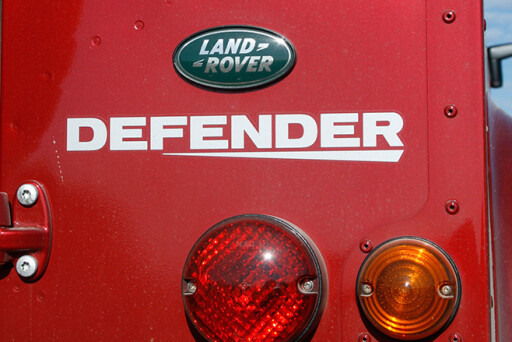 DRESSED UP
DRESSED UP
Starting at $42,800 for a standard 90, our test vehicle dips into the options list with metallic Firenze Red paint ($600), contrast ‘Santorini’ roof ($730), black ‘Saw Tooth’ alloy wheels with Continental Cross-Contact tyres ($750) and part-leather seats ($720). All that amounts to $45,600 before on-road costs.
SPECIFICATIONS
Engine: turbo-diesel inline four-cylinder
Capacity: 2198cc
Max Power: 90kW @ 3500rpm
Max Torque: 360Nm @ 2000rpm
Gearbox: six-speed manual
Crawl Ratio: 62.988:1
4X4 System: dual-range part-time
Construction: separate chassis
Front suspension: live axle/coil springs
Rear suspension: live axle/coil springs|
Kerb Weight: 1815kg
GVM: 2750kg
Payload: 935kg
Towing capacity: 3500kg
Seating capacity: 4
Fuel tank capacity: 60 litres
ADR fuel consumption*: 10.2 litres/100km
On-test fuel consumption: 12.0 litres/100km
*Australian Design Rule ‘Combined-Cycle’ claim

COMMENTS